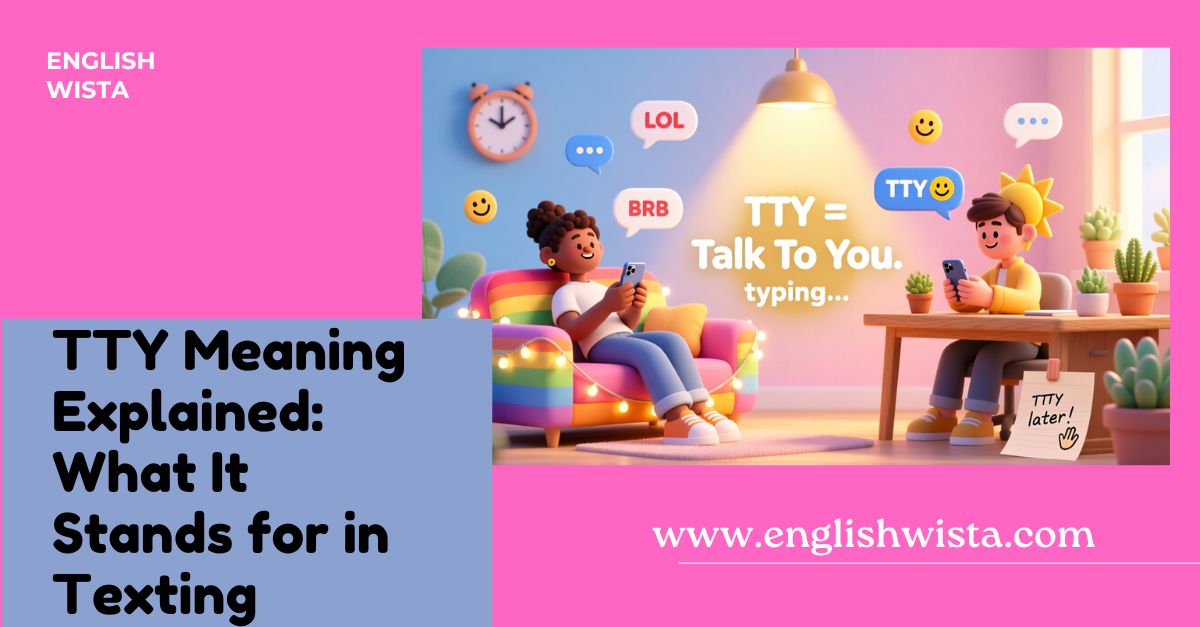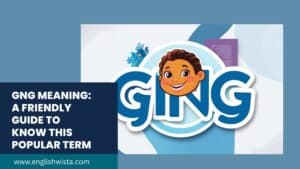Have you ever received a text or a chat message where someone wrote “TTY” and you had no idea what it meant? Don’t worry you’re not alone. The internet is full of abbreviations, acronyms, and short forms that can be confusing at first. Some of them are easy to guess, but others feel like a secret code only certain people understand. “TTY” is one of those terms that can leave people scratching their heads.
The good news? By the end of this article, you’ll know exactly what “TTY” means, when to use it, and how it fits into different conversations. We’ll also look at some fun facts, examples, and even clear up a few common mix-ups. Think of this as your friendly, no-stress guide to becoming a little more fluent in text-speak.
Let’s dive in!
What Does TTY Mean in Text?
The short answer is simple: TTY usually stands for “Talk To You.”
It’s a quick and casual way to tell someone that you’ll talk to them soon, either later in the same conversation or at another time. Instead of typing the whole phrase “talk to you,” people just shorten it to “TTY.”
So, when someone writes “TTY later,” they’re really saying “Talk to you later.”
This abbreviation makes texting faster and easier, especially when people are typing quickly on their phones.
Is TTY the Same as TTYL?
Great question! The abbreviation TTYL means “Talk To You Later.” It’s basically a slightly longer and more complete version of TTY.
Here’s the difference:
- TTY = Talk To You
- TTYL = Talk To You Later
Most of the time, you’ll see TTYL more often than TTY on its own. But some people do use TTY in casual chats, especially when they want to keep things short.
Real-Life Examples of TTY in Action
Let’s look at some everyday examples of how you might see “TTY” in a conversation.
- Friendship Chat:
- A: “Hey, I’m about to go into class. TTY later!”
- B: “Okay, good luck!”
- Work Chat:
- A: “I’ll send you the file soon. TTY after lunch.”
- B: “Sounds good, thanks.”
- Family Text:
- A: “Dinner’s ready at 7. TTY before then.”
- B: “Perfect, see you soon.”
As you can see, it’s just a friendly sign-off, letting the other person know that you’ll continue the conversation at a later time.
Common Confusion: Does TTY Always Mean “Talk To You”?
This is where things get a little tricky. TTY has more than one meaning depending on the context.
- In texting and chatting:
- TTY = Talk To You
- In technology and telecommunication (older usage):
- TTY = Teletypewriter, a device used for typing and sending text over phone lines, often used by people who are deaf or hard of hearing.
So, if you’re chatting with a friend online, you can safely assume it means “Talk To You.” But if you’re reading about phones, accessibility technology, or history, it might mean something else entirely.
How Did “TTY” Start Being Used in Texting?
The roots of “TTY” in the texting world come from people wanting to shorten phrases and save time. When SMS (short message service) first became popular in the early 2000s, each message was limited to 160 characters. That made abbreviations incredibly useful.
People quickly developed a “texting language” full of shortcuts like:
- LOL (Laugh Out Loud)
- BRB (Be Right Back)
- OMG (Oh My God)
- TTYL (Talk To You Later)
“TTY” was one of those shortcuts. While “TTYL” became the more common version, “TTY” still pops up now and then.
When Should You Use TTY?
You can use “TTY” in casual conversations when you want to keep things light and short. It works well as a sign-off or a way to pause the chat.
Good times to use TTY:
- When you’re leaving a conversation but plan to talk later
- When you’re busy but want to quickly acknowledge the person
- When you want a casual and friendly closing message
Not-so-good times to use TTY:
- In formal emails or professional settings (use full words instead)
- When talking to someone who may not understand texting slang
- When clarity is more important than speed
Example Sentences With TTY
Here are more practical examples so you can see how “TTY” works in context:
- “Thanks for the update! I’m heading out now, TTY soon.”
- “I’ll TTY once I’m done with my homework.”
- “No worries, TTY tomorrow about the details.”
- “That movie sounds great, TTY later about tickets.”
- “Can’t chat now, but TTY after dinner.”
Notice how it always signals a temporary goodbye rather than a permanent one.
Related Phrases and Alternatives
“TTY” isn’t the only phrase people use to wrap up a conversation. Here are a few other common alternatives you might see:
- TTYL – Talk To You Later
- BRB – Be Right Back
- GTG – Got To Go
- CU – See You
- HBU – How About You
Each one has a slightly different meaning, but they all fall under the category of quick, casual text talk.
Fun Facts About TTY
Let’s sprinkle in some extras to make this even more interesting:
- Double Meaning History:
Long before texting, “TTY” stood for “teletypewriter,” a machine invented in the 1920s. It allowed typed messages to be sent over phone lines. Later, it became essential technology for deaf communication. - TTYL Was Popularized by AIM:
In the early 2000s, AOL Instant Messenger (AIM) made “TTYL” super popular. People used it daily as a casual way to end chats. - A Book Named After It:
There’s even a young adult novel called TTYL by Lauren Myracle, written entirely in the style of instant messages.
Why Do People Still Use Abbreviations Like TTY?
Even though most modern messaging apps no longer limit characters, abbreviations still stick around. Why?
- Habit: People got used to using them.
- Speed: It’s quicker to type three letters than a whole sentence.
- Style: It feels casual and friendly, which fits texting culture.
In short, “TTY” lives on because it’s easy and feels natural in quick conversations.
Is TTY Outdated?
Some might wonder if “TTY” feels a little old-fashioned compared to other slang. It’s true that “TTYL” and even just “Talk later” are more common today. Still, you might see “TTY” from time to time, especially from people who grew up in the early days of texting.
So, while it may not be the trendiest abbreviation anymore, it’s not completely gone. It’s more like a “classic” piece of internet language.
Quick Recap
Before we wrap things up, let’s do a quick refresher on what we’ve learned:
- TTY means “Talk To You” in texting and chatting.
- It’s often used as a short, casual way to end a conversation.
- TTYL (Talk To You Later) is a more common variation.
- It can also mean “teletypewriter” in a completely different context.
- It’s best used in casual, friendly conversations rather than formal ones.
- Even though it’s less common today, it’s still part of the texting language many people recognize.
Conclusion
So, the next time someone writes “TTY” in a text, you won’t be left guessing. You’ll know it means “Talk To You” and that the person is simply pausing the chat with the intention of picking it up later.
Texting abbreviations like TTY may seem confusing at first, but once you learn them, they become second nature. Think of them as little shortcuts that make communication quicker and sometimes even more fun.
And remember if you’re ever unsure about an abbreviation, you can always ask. Chances are, the person on the other end of the message will be happy to explain.
For now, we’ll wrap this up the same way you might in a text conversation: TTY later!



